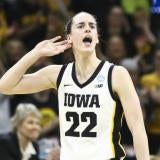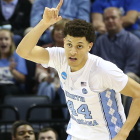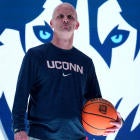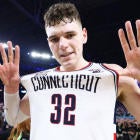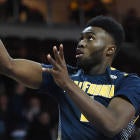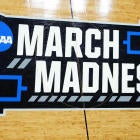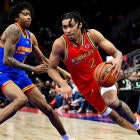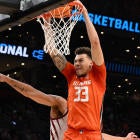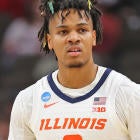We have some time to kill before Saturday’s games tip, so let’s look at the 20 projected starters in this year’s Final Four and sort them from worst to best. And “worst” is too harsh a term, but you get what I mean.
In reviewing how I sorted out the 20 guys, the 14-8 range was the toughest area. There are a lot of differences in these players. Some guys listed below others have certain strengths that make them dangerous and irresistible. This is not a list based on potential as an NBA player or anything like this. This list is purely based on, if these guys were all on a playground and I had first pick, I would go in this order.
20. Maik Kotsar, South Carolina: The freshman big man hit the 15-footer in the closing minute of the win over Florida. He’s still a puppy, though. Kotsar’s efficiency numbers this season have not been good, and for someone who’s 6-feet-10, he’s still finding his aggressiveness around the tin. I’ll be interested to see how he deals with the hoss that is Przemek Karnowski on Saturday.
19. Payton Pritchard, Oregon: Skinny freshman shooter who has had a few “whoa-there” moments from the field this season. Pritchard is a starter, yet is only involved in about 15 percent of Oregon’s possessions, meaning he’s scoring or assisting only that amount of the time. Unusual for someone who gets his name called in the intros. Also, his assist rate is 20.8, which falls below Dillon Brooks’ 23.8 clip. Pritchard is the point guard; Brooks is a combo forward.
18. Josh Perkins, Gonzaga: Perkins is the only Zags starter who doesn’t average double digits. He’s the least efficient points-per-possession scorer of the Bulldogs starters, and is the only guy of the starting five who’s not a threat to have takeover spurts in games. Yet, at 40.5 percent from 3 on 150 attempts this season, he’s certainly capable of being the big-shot guy if Gonzaga is in a close game late. Of course, that has not happened many times this season.
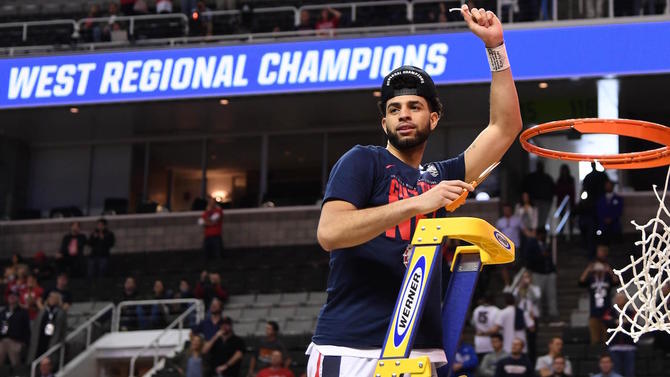
17. Duane Notice, South Carolina: A 6-2 guard with thickness and toughness that rounds up South Carolina’s matchup zone very well. He’s not a great shooter, but I loved watching him defend at Madison Square Garden last weekend. He has been part of the core of Frank Martin’s construction job at South Carolina. Though Sindarius Thornwell is obviously South Carolina’s best player, Notice’s contributions are almost barometer-like in how South Carolina does. He peppers the box score, doing just enough. Yes, a glue guy.
16. Dylan Ennis, Oregon: Poised defender whose presence in Oregon’s starting five really emphasizes how solid this group is. There’s a reason the Ducks were a preseason top-five team, you know. Ennis has something no one else on this list does: age. He’s 25. That’s incredible. But that’s what will happen when you enroll in college older than most others in your class, then transfer, then lose a year to injury. Ennis’ experience might wind up being invaluable, but of course no team left in this tournament is operating with newbies.
15. Chris Silva, South Carolina: He didn’t show up in the first half of the Florida game and South Carolina trailed by seven at the break. Then he became the second-best player on the floor for most of the second half, and what do you know, South Carolina found its command. Silva shoots 54 percent, draws a lot of fouls, hits his free throws 75 percent of the time and is a solid power wing with interior-first tendencies. Personally, I would love to see him face up against Jordan Bell. If Silva, a sophomore, was a little more consistent, I would rank him higher.
14. Kennedy Meeks, North Carolina: If you’re feeling strong about UNC winning the title, here’s another reason for it. UNC’s worst starter ranks 14th out of 20, the best of any group here. Meeks hasn’t made vast improvements from last season (he was ranked 18th last year in our top 20 Final Four starters piece), but he’s certainly better. And he’ll probably do well if UNC gets to the title game. He won’t be threatened by athleticism from either of those two teams, and the rebounding battle will be a fun one to watch. Meeks is the 10th-best offensive rebounder in college basketball. He’s also the only liability from the foul line of all the UNC starters.
13. Jordan Mathews, Gonzaga: Mathews’ 3-pointer late against West Virginia was one of the biggest shots of the tournament. Gonzaga didn’t need the rushed bucket in that moment, but it wound up being crucial, as points were at a premium in that 61-58 Bulldogs win. Mathews only shoots 40 percent from the field, but I would still take him before the guys I have listed 14-20. I think he has been a necessary addition to Gonzaga’s historic season. A fun shooting guard who can attack and isn’t prone to turning it over.
12. Isaiah Hicks, North Carolina: The senior power forward is still anonymous on the national level, but he shoots 60 percent and gets opponents in the front court into foul issues somewhat frequently. He’s more skilled than Meeks and averages 12.1 points. Could do more if needed, but that’s now how Roy Williams runs his offense. Absolutely the one guy on this list who is better than his numbers indicate. Actually, I take that back, because this next guy qualifies to a stronger degree.
11. Theo Pinson, North Carolina: I have seen UNC with Theo Pinson and I have seen UNC without Theo Pinson, and there is very much a difference -- the former is much better. Now, when Pinson isn’t in then you get Nate Britt as a starter. But I would expect Pinson to get the nod against Oregon. He’s a spark plug. He also lured the Kentucky defense into the paint then kicked it out to Luke Maye for the winner in the Elite Eight. Pinion averages just six points but also provides 4.2 rebounds and 3.7 assists. He’s not consistent, but I love his game. He is a really fun basketball player, someone who turns North Carolina into a title team when he’s involved.
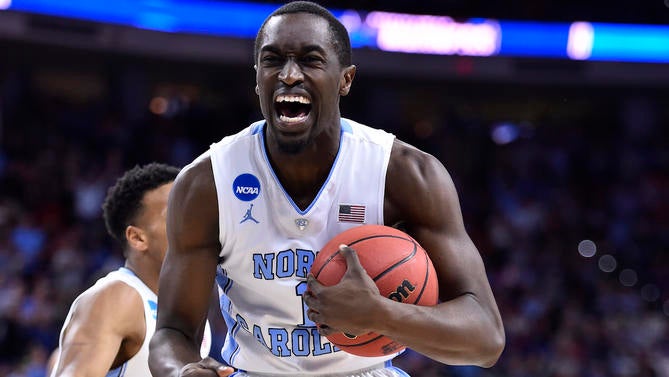
10. P.J. Dozier, South Carolina: I will say this: If P.J. Dozier plays against Gonzaga the way he showed up against Florida, I would rank him closer to sixth than 10th on this list. Dozier was a McDonald’s All-American in high school. At the East Region, I sat next to one of the great newspaper columnists in America, Sally Jenkins of the Washington Post. She pointed out to me how Dozier moves about the floor: coasting through the traffic as though he had the balance of a surfer. I thought, how apt. It’s true. Dozier averages 13.8 points, 4.7 rebounds and 2.8 assists. Sindarius Thornwell graduates this year. If Dozier opts to return, he’ll have a chance at SEC Player of the Year.
9. Jordan Bell, Oregon: No one has had a bigger breakout month than Bell. Thornwell was at least known as a really good player, someone who won SEC Player of the Year. Bell was just an athletic piece on an interesting Oregon team for most of the season. Then the tournament came and he evolved into a defensive beast unlike anything we had ever seen from him before. He set a program postseason record with eight blocks in the Kansas game. He has single-handedly made up for the loss of Chris Boucher. Offensively you can’t count on him for too much other than to pick up the trash on the glass, but he is the best overall defender of any player listed.
8. Johnathan Williams, Gonzaga: My goodness did you see J-Williams in that Xavier game? This 6-9 ferocity of a power forward had, I think, his best game in a Zags uni -- especially when you consider the circumstances. Williams scored 19 on 8-of-12 shooting, had eight boards, three blocks and two steals. He’s averaging 10.3 points and 6.6 rebounds and takes good shots while doing it. No one on Gonzaga is good at more things on both ends of the floor than Williams. He’s not a great player, but he’s really good and shows flashes of greatness. He’ll need to do it again in order to secure the Zags a title.
7. Przemek Karnowski, Gonzaga: Big Shem has that big beard and it makes for a fun watch. He’s the one guy in this Final Four where so-called casual college basketball fans can be like “Oh, yeah, that guy!” I would argue that, at this point, so-called casual fans (the people in bracket pools, the ones watching this tournament) know every player listed seventh and above. Karnowski, remember, sat out last season because of a back injury that threatened his carer. He returned and wound up being the centrifuge to Gonzaga’s offense, a back-to-the-basket brute with a feathery touch and third-eye sense for passing. He’s my favorite player in this Final Four. Some might forget, but when Mark Few landed him, there was a lot of hype about his ability. His addition to Gonzaga’s program, in 2012, was the thing that made some believe a Final Four could be possible. Now look at the Bulldogs. Karnowski averages 12.2 points on 60 percent shooting in 23 minutes per game.
6. Joel Berry, North Carolina: Up four spots from a season ago. Berry’s ankles are the question. He tweaked both of them last weekend. Of course he’s vital, and of course he’s a really good player. The junior floor general averages 14.6 points, 3.6 assists, 3.1 rebounds and hits 39 percent of his 3-point attempts. He has a great pace and a reliable instinct for when to drive and when to he can set up his defender to a bad spot to allow him to hoist a 3 or play off the top of the key. In a tight game, UNC wants him at the line. Carolina cannot win the title unless he’s at 85 percent or better, health-wise.
5. Tyler Dorsey, Oregon: Dorsey has been the second-best player in this tournament, but I’m still taking into account the guy as a whole and comparing his game to everyone else. Sure he has been a flame-thrower, someone who has become the most dangerous 3-point threat in the Final Four. I get that. Dorsey is an absolute killer. But he’s also not a consistent defender. Dorsey averages 14.5 points and 3.4 rebounds. If he continues to play the way he has (24.5 points in his past four games on a ridiculous 17 of 26 from 3-point range), then it’s going to hard to beat Oregon. Very hard.
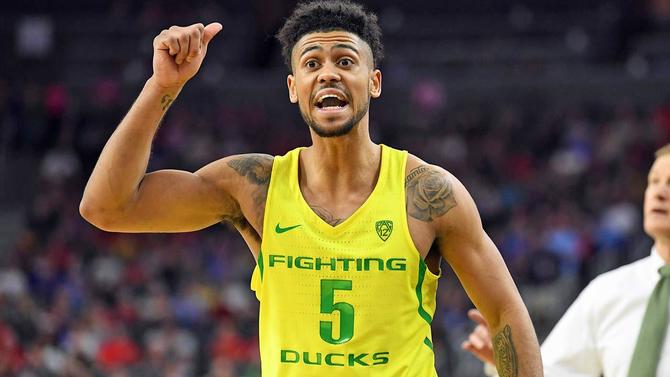
4. Nigel Williams-Goss, Gonzaga: In a season dominated by point guards, but wherein most point guards who got the love were named Ball, Fox, Fultz, Smith, Monte Morris or Jawun Evans, NWG played at an All-American level most of the season. He was, at worst, the sixth-best player in the country this season. As that accomplishment pertains to this list, it just so happens that two of the three players ranked ahead of him were more valuable, and the other one has a higher ceiling. But Williams-Goss (16.7 ppg, 5.9 rpg, 4.6 apg, 1.8 spg) has the all-around headiness that makes Gonzaga winning a national title a possibility. I love his decision-making. If he returns to college basketball next season, he will have a chance to be the preseason choice for Player of the Year.
3. Dillon Brooks, Oregon: Way back in October, this guy was my pick for Player of the Year. It didn’t work out that way, due in part to Brooks missing the first four games to injury. And in fact Brooks has been Oregon’s third-best player in this tournament -- but he was the Pac-12 Player of the Year (you’ll notice the top four players listed here all won their league POY honors). He scores 16.3 points per game on top of 3.1 rebounds and 2.8 assists. I love Brooks’ game because he’s cocky and runs hot. His competitive nature sometimes gets him into trouble, and he has a penchant for laughable flops, but there aren’t many players in contemporary college basketball who drip with emotion on an almost every-play basis. At his best, against every other player at their best, he’s No. 3 among all the guys remaining in this tournament.
2. Sindarius Thornwell, South Carolina: If you want to make the case for the best-named player in this Final Four (Gonzaga’s Killian Tillie takes second; UNC’s Seventh Woods wins the bronze) as the best player in this Final Four, you have a great case. Thornwell is, by far, the foremost reliable player on both ends of the floor. He is tasked with guarding the other team’s best player, then has to go average 21.6 points while being guarded by the other team’s best defender. His perimeter work on the defensive end (2.2 steals) is all guts, and he still makes time to average three assists in addition to seven rebounds. He’s so confident operating in traffic you would think he could survive an avalanche.
1. Justin Jackson, North Carolina: Huge jump for Jackson, who was ranked 13th last year. Jackson has the highest current projected NBA potential of any player, but I’m all in on him at the college level. He has significantly upped his scoring average (12.2 to 18.2) and become a much better 3-point shooter (29 to 38 percent) while being called upon for more offensive responsibilities. Jackson can operate in the open floor, can score at all three levels and has become one of the 10 best players in college basketball. He’s the quietest UNC star I can remember. In fact, this season’s UNC team, though it has vets, is void of superstar talent. Jackson is the closest thing, but his game doesn’t lend itself to highlights on top of highlights. Instead, he’s often in the right place making the right decision. I take him just barely over Thornwell because I trust him more with the ball, and at 6-8, he’s a matchup problem in more ways than Thornwell is. If UNC is to win the title, he’ll have to be its best player.








